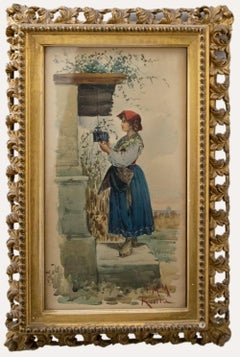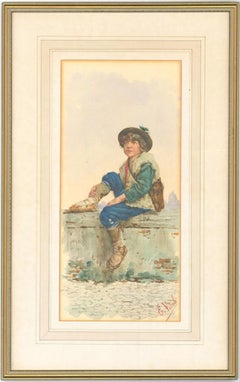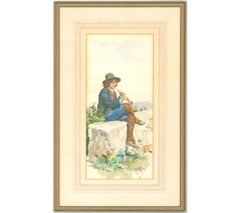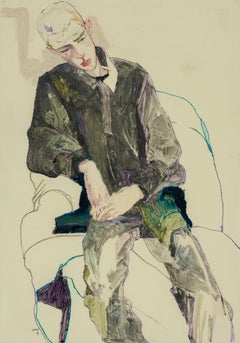Eduard Vitali Art
to
2
3
1
3
1
2
Overall Height
to
Overall Width
to
3
2
1
1
1
1
1
1
3
3
6,847
3,162
2,517
1,217
3
3
Artist: Eduard Vitali
Eduard Vitali - 19th Century Watercolour, The Oil Lamp
By Eduard Vitali
Located in Corsham, GB
A charming study of an Italian woman replacing the oil lamp outside of her home. She wears traditional, brightly coloured clothing with a red headpiece. Signed with initials and insc...
Category
19th Century Eduard Vitali Art
Materials
Watercolor
Eduard Vitali - Signed and Framed 19th Century Watercolour, Boy Sat on a Wall
By Eduard Vitali
Located in Corsham, GB
Presented in a washline mount and simple frame. Signed. On wove.
Category
19th Century Eduard Vitali Art
Materials
Watercolor
Eduard Vitali - Signed and Framed 19th Century Watercolour, Boy with a Flute
By Eduard Vitali
Located in Corsham, GB
Presented in a washline mount and simple frame. Signed. On wove.
Category
19th Century Eduard Vitali Art
Materials
Watercolor
Related Items
The Abduction of the Sabine Women , a Renaissance drawing by Biagio Pupini
Located in PARIS, FR
This vigorous drawing has long been attributed to Polidoro da Caravaggio: The Abduction of the Sabine Women is one of the scenes that Polidoro depicted between 1525 and 1527 on the façade of the Milesi Palazzo in Rome. However, the proximity to another drawing inspired by this same façade, kept at the Ecole des Beaux-Arts, and to other drawings inspired by Polidoro kept at the Musée du Louvre, leads us to propose an attribution to Biagio Pupini, a Bolognese artist whose life remains barely known, despite the abundant number of drawings attributed to him.
1. Biagio Pupini, a Bolognese artist in the light of the Roman Renaissance
The early life of Biagio Pupini, an important figure of the first half of the Cinquecento in Bologna - Vasari mentions him several times - is still poorly known. Neither his date of birth (probably around 1490-1495) nor his training are known. He is said to have been a pupil of Francesco Francia (1450 - 1517) and his name appears for the first time in 1511 in a contract with the painter Bagnacavallo (c. 1484 - 1542) for the frescoes of a church in Faenza. He then collaborated with Girolamo da Carpi, at San Michele in Bosco and at the villa of Belriguardo.
He must have gone to Rome for the first time with Bagnacavallo between 1511 and 1519. There he discovered the art of Raphael, with whom he might have worked, and that of Polidoro da Caravaggio. This first visit, and those that followed, were the occasion for an intense study of ancient and modern art, as illustrated by his abundant graphic production.
Polidoro da Caravaggio had a particular influence on the technique adopted by Pupini. Executed on coloured paper, his drawings generally combine pen, brown ink and wash with abundant highlights of white gouache, as in the drawing presented here.
2. The Abduction of the Sabine Women
Our drawing is an adaptation of a fresco painted between 1525 and 1527 by Polidoro da Caravaggio on the façade of the Milesi Palace in Rome. These painted façades were very famous from the moment they were painted and inspired many artists during their stay in Rome. These frescoes are now very deteriorated and difficult to see, as the palace is in a rather narrow street.
The episode of the abduction of the Sabine women (which appears in the centre of the photo above) is a historical theme that goes back to the origins of Rome and is recounted both by Titus Livius (Ab Urbe condita I,13), by Ovid (Fasti III, 199-228) and by Plutarch (II, Romulus 14-19). After killing his twin brother Romus, Romulus populates the city of Rome by opening it up to refugees and brigands and finds himself with an excess of men. Because of their reputation, none of the inhabitants of the neighbouring cities want to give them their daughters in marriage. The Romans then decide to invite their Sabine neighbours to a great feast during which they slaughter the Sabines and kidnap their daughters.
The engraving made by Giovanni Battista Gallestruzzi (1618 - 1677) around 1656-1658 gives us a good understanding of the Polidoro fresco, allowing us to see how Biagio Pupini reworked the scene to extract this dynamic group.
With a remarkable economy of means, Biagio Pupini takes over the left-hand side of the fresco and depicts in a very dense space two main groups, each consisting of a Roman and a Sabine, completed by a group of three soldiers in the background (which seems to differ quite significantly from Polidoro's composition).
The balance of the drawing is based on a very strongly structured composition. The drawing is organised around a median vertical axis, which runs along both the elbow of the kidnapped Sabine on the left and the foot of her captor, and the two main diagonals, reinforced by four secondary diagonals. This diamond-shaped structure creates an extremely dynamic space, in which centripetal movements (the legs of the Sabine on the right, the arm of the soldier on the back at the top right) and centrifugal movements (the arm of the kidnapper on the left and the legs of the Sabine he is carrying away, the arm of the Sabine on the right) oppose each other, giving the drawing the appearance of a whirlpool around a central point of support situated slightly to the left of the navel of the kidnapper on the right.
3. Polidoro da Caravaggio, and the decorations of Roman palaces
Polidoro da Caravaggio was a paradoxical artist who entered Raphael's (1483 - 1520) workshop at a very young age, when he oversaw the Lodges in the Vatican. Most of his Roman work, which was the peak of his career, has disappeared, as he specialised in facade painting, and yet these paintings, which are eminently visible in urban spaces, have influenced generations of artists who copied them abundantly during their visits to Rome.
Polidoro Caldara was born in Caravaggio around 1495-1500 (the birthplace of Michelangelo Merisi, known as Caravaggio, who was born there in 1571), some forty kilometres east of Milan. According to Vasari, he arrived as a mason on the Vatican's construction site and joined Raphael's workshop around 1517 (at the age of eighteen according to Vasari). This integration would have allowed Polidoro to work not only on the frescoes of the Lodges, but also on some of the frescoes of the Chambers, as well as on the flat of Cardinal Bibiena in the Vatican.
After Raphael's death in 1520, Polidoro worked first with Perin del Vaga before joining forces with Maturino of Florence (1490 - 1528), whom he had also known in Raphael's workshop. Together they specialised in the painting of palace façades. They were to produce some forty façades decorated with grisaille paintings imitating antique bas-reliefs.
The Sack of Rome in 1527, during which his friend Maturino was killed, led Polidoro to flee first to Naples (where he had already stayed in 1523), then to Messina. It was while he was preparing his return to the peninsula that he was murdered by one of his assistants, Tonno Calabrese, in 1543.
In his Vite, Vasari celebrated Polidoro as the greatest façade decorator of his time, noting that "there is no flat, palace, garden or villa in Rome that does not contain a work by Polidoro". Polidoro's facade decorations, most of which have disappeared as they were displayed in the open air, constitute the most important lost chapter of Roman art of the Cinquecento. The few surviving drawings of the painter can, however, give an idea of the original appearance of his murals and show that he was an artist of remarkable and highly original genius.
4. The façade of the Milesi Palace
Giovanni Antonio Milesi, who commissioned this palace, located not far from the Tiber, north of Piazza Navona, was a native of the Bergamo area, like Polidoro, with whom he maintained close friendly ties. Executed in the last years before the Sack of Rome, around 1526-1527, the decoration of Palazzo Milesi is considered Polidoro's greatest decorative success.
An engraving by Ernesto Maccari made at the end of the nineteenth century allows us to understand the general balance of this façade, which was still well preserved at the time. The frescoes were not entirely monochrome, but alternated elements in chiaroscuro simulating marble bas-reliefs and those in ochre simulating bronze and gold vases...
Category
16th Century Old Masters Eduard Vitali Art
Materials
Ink, Gouache, Pen
Lee Hurst (3/4 Figure, Hands Together), Mixed media on Pergamenata parchment
By Howard Tangye
Located in London, GB
Howard Tangye (b.1948, Australia) has been an influential force in fashion for decades. Lecturing at London’s Central Saint Martins for 35 years, including 16 years as head of BA Wom...
Category
2010s Contemporary Eduard Vitali Art
Materials
Paint, Paper, Parchment Paper, Charcoal, Crayon, Oil Crayon, Oil Pastel,...
Feeling by Annemarie Ambrosoli, watercolor on paper, 50x30cm
By Annemarie Ambrosoli
Located in Kiens, BZ
Feeling (2018) is a watercolor by contemporary artist Annemarie Ambrosoli that measures 49,5x29,5 cm.
It is framed with a cream white passepartout, measuring 63,7x43,5 cm and with a...
Category
2010s Contemporary Eduard Vitali Art
Materials
Watercolor
Freya (Seated Backwards), Mixed media on grey board
By Howard Tangye
Located in London, GB
Howard Tangye (b.1948, Australia) has been an influential force in fashion for decades. Lecturing at London’s Central Saint Martins for 35 years, including 16 years as head of BA Wom...
Category
2010s Contemporary Eduard Vitali Art
Materials
Other Medium, Archival Paper, Handmade Paper, Pen, Felt Pen, Permanent M...
Orange Vests
By Brian Stonehouse
Located in London, GB
Gouache and charcoal on paper, 53cm x 37cm (74cm x 55cm framed). Provenance: the Artist’s estate (stamped verso).
Stonehouse had an extraordinary life. As a young art student studying fashion illustration, he joined the Royal Artillery at the beginning of WWII but soon became a part of the Special Operations Executive (SOE). He was sent to France as a radio operator but three and a half months later was caught by the Gestapo, tortured, given a death sentence and then selected for slave labour. He spent the subsequent war years in three French prisons and five concentration and labour camps, including Dachau. He still managed to continue to draw in some of the camps. Following the war, Stonehouse went to the US and continued his career as a fashion artist painting for magazines...
Category
1970s Post-War Eduard Vitali Art
Materials
Paper, Gouache, Charcoal
Cabaret Dancers girls Austrian watercolor painting in fraimed 1930s
By Richard Geiger
Located in Stockholm, SE
Signed: by Richard Geiger (1870 – 1945), Austrian - Hungarian painter. Also pencils inscriptions on reverse with date 33 (1933). By the 1920s, he worked illustrating books, bookplates and posters. His paintings included portraits, nudes, genre paintings, and mythological scenes, but he was known for his illustrations, especially his carnival motifs. Spectacular masterwork.
Size app.: 18 x 23.3 cm (roughly 7.1 x 9,2 in), framed 31.7 x 36.4 cm (roughly 12.5 x 14.3 in). Very Good condition, minimal age wear. In person actual painting may appear darker or brighter than in our pictures, strictly depending on sufficient light in your environment. Please study good resolution images for overall cosmetic condition. Glass will be removed prior to shipment for safe transit. Weight of app. 0,5 kg (without glass!) is going to measure some 2 kg volume weight packed for shipment.
R. Geiger was born in Vienna. He first attended a drawing school and then studied at the Academy of Fine Arts Vienna, where he studied under Christian Griepenkerl and August Eisenmenger. He studied sculpture with Fritz Klimsch at the Academy of Arts in Berlin. There he took part in the exhibitions of the Academy with his portrait busts and sculptures. In Paris he studied at the Julian Academy and worked in the studio of François Flameng...
Category
1930s Realist Eduard Vitali Art
Materials
Wood, Paper, Watercolor
Regency portrait drawing of Lady Nugent
By John Downman
Located in London, GB
Collections:
With Ellis Smith, London;
Private collection, to 2015.
Literature:
G.C. Williamson, John Downman A.R.A., his Life and Works,
p. lviii no's. 2 and 3, p. xxxi.
Exhi...
Category
19th Century Old Masters Eduard Vitali Art
Materials
Pencil, Watercolor
Portrait Old Master, Joseph Vivien, Mme Silvestre, French Rococo, Pastel
By Joseph Vivien
Located in Greven, DE
The portrait shows Mme Silvestre.
Born in Paris, Silvestre was the daughter of Charles-Antoine Hérault and his wife Marie-Geneviève, who were her first teachers. In 1706 she married the painter Louis de Silvestre, moving with him in 1716 to Dresden. The couple's daughter Marie-Maximilienne became a pastellist. Silvestre died in Dresden, the year before her husband retired and returned to Paris. Her surviving pastels show the influence of Rosalba Carriera...
Category
18th Century Rococo Eduard Vitali Art
Materials
Gouache, Oil Pastel
H 31.11 in W 23.63 in
Oriental Woman, Nineteenth Watercolor, Signature To Identify
Located in SAINT-OUEN-SUR-SEINE, FR
Oriental woman.
19th century watercolor.
Signature to be identified.
Framed and under glass.
Watercolor (at sight): 20.5 x 10 cm
Frame: 33.5 x 23 cm
Category
19th Century Eduard Vitali Art
Materials
Watercolor
French Art, Rococo Portrait, Oval, Pastel, Portrait of a Lady, Circle of Vivien
Located in Greven, DE
French School, Portrait of a Lady, Rococo, 18th Century, Fine drawing in Pastel/ Oil Pastel on Paper in the style of Vivien. The Lady might be a woman from Marie Antoinette's Court. It is part of a Pendant (see the other listing with the portrait of Queen Marie Antoinette...
Category
18th Century Rococo Eduard Vitali Art
Materials
Paper, Oil Pastel, Gouache
Oleg (Kimono), Mixed media on ochre parchment paper
By Howard Tangye
Located in London, GB
Howard Tangye (b.1948, Australia) has been an influential force in fashion for decades. Lecturing at London’s Central Saint Martins for 35 years, including 16 years as head of BA Wom...
Category
2010s Contemporary Eduard Vitali Art
Materials
Paint, Paper, Parchment Paper, Charcoal, Crayon, Oil Crayon, Oil Pastel,...
Moses With the Ten Commandments
By Sir Jacob Epstein
Located in New York, NY
Moses With the Ten Commandments by Sir Jacob Epstein (1880-1959)
Pencil and watercolor on paper
22 x 16 ⅝ inches unframed (55.88 x 42.24 cm)
28 ½ x 23 inches framed (72.39 x 58.42 cm)
Signed on bottom left
Description:
In this figurative watercolor painting, Jacob Epstein depicts Moses holding two tablets, one in each arm, that are inscribed with the ten commandments. This is a visualization of the traditional biblical story in which Moses goes to Mount Sinai and has the ten commandments revealed to him by God which he inscribed onto two tablets and keeps in the Ark of the Covenant...
Category
20th Century Post-Modern Eduard Vitali Art
Materials
Watercolor, Pencil
Eduard Vitali art for sale on 1stDibs.
Find a wide variety of authentic Eduard Vitali art available for sale on 1stDibs. You can also browse by medium to find art by Eduard Vitali in paint, watercolor and more. Not every interior allows for large Eduard Vitali art, so small editions measuring 12 inches across are available. Eduard Vitali art prices can differ depending upon medium, time period and other attributes. On 1stDibs, the price for these items starts at $388 and tops out at $435, while the average work can sell for $412.




